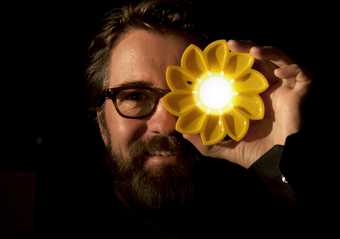Tate Modern
28 July 2012
As part of Olafur Eliasson: Little Sun at Tate Modern, to be launched on 28 July 2012, visitors will be invited to look at works of art in the dark using only the light of Eliasson’s Little Sun solar-powered lamps. The presentation at Tate Modern has been developed for the London 2012 Festival that runs across the UK until 9 September 2012.
Olafur Eliasson is probably best-known for his highly successful The weather project (2003), part of the Unilever Series in Tate Modern’s Turbine Hall, which drew over 2 million visitors during its five-month installation.
The artist has developed the Little Sun solar-powered lamp with the engineer Frederik Ottesen to focus attention on the power of solar light to improve lives. Around 1.6 billion people worldwide live without access to mains electricity. Many of them rely on kerosene lanterns for lighting, which is both expensive and a health hazard. Little Sun brings light to people in off-grid locations, enabling them to work, reduce household expenses and improve the quality of life.
Starting on 28 July, people will be invited to participate in Tate Blackouts on Saturday nights after ordinary museum hours. For two hours, the lights will go off in the former power station and visitors can look at the works of art in the suite of galleries devoted to Tate Modern’s Surrealist collection using only the light of Little Sun lamps. This echoes the 1938 International Surrealist Exhibition at the Galérie des Beaux-Arts,Paris, where Man Ray (as ‘Master of Light’) supplied the visitors with torches to explore the labyrinthine galleries.
Beyond the Tate Blackout events, Olafur Eliasson: Little Sun will feature in a space on the third floor of the gallery from 28 July to 23 September, where visitors can learn about solar power, the global energy challenge, light and its importance in and for life. It will also include a special set-up for people to do light graffiti using the Little Sun and offer the opportunity to buy a lamp for £16.50 (€22). In off-grid areas the price will be reduced to about half that amount.
Little Sun produces 5 hours of light when it is charged in the sun for 5 hours. It facilitates the creation of small businesses to sell the lamp and, by concentrating profits at the point of need, it aims to promote economic growth in regions of the world where electricity is not available, reliable, affordable, or sustainable. Little Sun is light for studying, sharing, cooking, and earning. It is light for life.
Little Sun events in September will include a seminar and the premiere of 16 short films on light, life, and Little Sun by filmmakers from off-grid areas around the world.
Olafur Eliasson said:
Over the years, I have been absorbed by phenomena such as light, time, the negotiation of space, compassion and the relation between body, mind, and action. Little Sun brings these different strands of my work together – this is a very important step for me. By bringing Little Sun to Tate Modern and the London Olympics, I hope to realise an art project for those who typically have no access to global events of this scale.
Nicholas Serota, Director, Tate said:
Olafur Eliasson is an artist whose work has always sought to bring new technologies to the service of art. In the Little Sun project, he has made a beautiful object with an immense social and economic value, which has the potential to change lives in off-grid areas of the world. Tate Modern, which hosted his Weather Project, is the natural place to launch this new venture.
Ruth Mackenzie, Director Cultural Olympiad and London 2012 Festival said:
I hope that some of our Festival experience will live with you forever and I believe that Olafur Eliasson’s Little Sun commission fits into that category. The artist who drew vast crowds to Tate Modern with his Weather Project has come up with another kind of sun to help people across the world in off-grid areas. This is a wonderful example of how the Olympic spirit and Olympic values can inspire artists as well as athletes.
Olafur Eliasson (IS/DK), born 1967, describes his works as ‘experimental setups’, span photography, installation, sculpture, and film. Around 55 craftsmen, artists, architects, and art historians work in his Berlin studio.
The 2007 SFMOMA exhibition Take your time: Olafur Eliasson travelled until 2010. Innen Stadt Aussen (Inner City Out), 2010, and Seu corpo da obra (Your body of work), 2011, involved interventions across the cities of Berlin and São Paulo in addition to works in museums.
Projects in public space include Green river, realised in various cities between 1998 and 2001; the Serpentine Gallery Pavilion 2007, London, with Kjetil Thorsen; and The New York City Waterfalls, 2008. Recent architectural works are Your rainbow panorama, for ARoS Aarhus Kunstmuseum, and Harpa Reykjavik Concert Hall and Conference Centre, with Henning Larsen Architects.
As a professor at the Berlin University of the Arts, Olafur Eliasson has run the Institut für Raumexperimente (Institute for Spatial Experiments), an innovative model for arts education, since April 2009.

